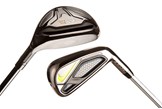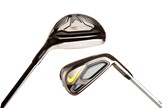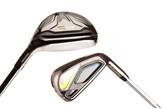When should you replace irons with hybrids?
Published: Last updated:
Modern golfers are increasingly buying sets of irons from 5, 6 or even 7-iron to PW.
Whereas just a few years ago a standard set started with a 3 or 4-iron, manufacturers are replacing those with forgiving wide-body hybrids.
Ping and TaylorMade make #3, #4 #5 & #6 hybrids, while Callaway makes a #7 too, which means you could just use an 8-iron to PW!
TOP STORIES
Which hybrid test: Wide body v narrow body
Best drivers for £150 test 2016
But how do you choose? Is it as simple as just replacing the irons you remove from your set with the equivalent number hybrid? Or is there more to it?
We asked TaylorMade – makers of one of our favourite 2016 hybrids – to send us a #4, #5 and #6 M2 hybrid. Equipment Editor Simon Daddow, who’s keen on keeping the game as easy as possible, hit each against his current Nike Vapor Fly irons on a SkyTrak launch monitor at The National Golf Academy at The Belfry.
Some serious number crunching revealed the differences between long iron and hybrid performance in the hands of a 10-handicap club golfer and ultimately spelt out how many hybrids might be too many.
TaylorMade M2 Rescue #4 v Nike Vapor Fly 4-iron

TaylorMade M2 Rescue #4H £159, Loft 22°, Stock length 40.25in (g)
Nike Vapor Fly 4-iron £n/a individually, Loft 21°, Stock length 38.25in (s)
Key numbers hybrid / iron
Club speed: 83mph / 80mph
Ball speed: 121mph / 116mph
Launch angle: 14.8°/ 13.2°
Backspin: 3180rpm / 3397rpm
Carry distance: 203 yards / 185 yards
Head-to-head
The lofts are very similar, yet for some irons on the market a 21° loft would be closer to a 3-iron than a 4. Lofts of some irons have been cranked down, so shots go further, but in reality you’re hitting a club more. So it’s no wonder golfers have more difficulty launching long irons than hybrids from the deck. The iron shaft is 2in shorter, which meant a drop of 3mph of head speed compared to the hybrid, which obviously has a huge impact on how far shots carry. Look at the data closely and you’ll see the iron launching 1.6° lower, too, which confirms everything we’ve been told about how difficult 4-irons can be to hit successfully. Naturally, the iron flew lower, which means a shallower descent into the greens, making it more difficult to hold shots on the dancefloor as well.
Our verdict
Golf’s a mental game, and the idea of standing further from the ball and knowing a decent swing is the only option if I’m to get anywhere close to my target immediately piled the pressure on. If you’re confident hitting a 4-iron from the turf we don’t want to change your thinking. Thank your lucky stars you’ve been blessed with enough club speed and a decent swing to hit one of modern golf’s most unforgiving clubs… But for me these numbers make a great case for hybrids. Ball speed is 5mph faster; shots launched and flew higher, so will stop faster; and the hybrid carried shots 18 yards further. What I did realise, though, is how closely a #3 and #4 hybrid are matched at my slower swing speed. With just three yards of carry difference between them, both can’t have a place in my bag.
TaylorMade M2 Rescue #5 v Nike Vapor Fly 5-iron

TaylorMade M2 Rescue #5H £159, Loft 25°, Stock length 39.75in (g)
Nike Vapor Fly 5-iron £n/a individually, Loft 24°, Stock length: 37.75in (s)
Key numbers hybrid / iron
Club speed: 83mph / 83mph
Ball speed: 117mph / 112mph
Launch angle: 16.5°/ 17.7°
Backspin: 4655rpm / 5377rpm
Carry distance: 186 yards / 172 yards
Head-to-head
The lofts of the #5 hybrid and iron are much the same, but again there’s a 2in difference in shaft length, so considerable difference in performance should be expected. The numbers don’t lie, and a jump of 5mph in ball speed switching to the hybrid equalled a 14-yard increase in carry distance, which is great as long as gapping between neighbouring clubs is good. Whereas launching a 4-iron off the fairway felt like hard work, it wasn’t quite the same with the 5. Many golfers will no doubt associate with this. Absolutely I’d like to feel more confident with a 5-iron in my hands, and if I’m honest it’s one club in my bag
I would consider swapping out for a better-performing hybrid. But that has to be based on the numbers, and gapping to my 6-iron stacking up as well.
Our verdict
This is where it starts to get tricky. I’ve got no qualms ditching a 4-iron for a hybrid, but relinquishing the 5 feels like a weakness. A declaration that we’re not as good as our playing partners, which nobody wants to admit to. But this sort of thinking can definitely hold you back. If there’s any doubt that you’re not great with a 5-iron, we challenge you to try a #5 hybrid. See how easy it is to launch from the turf and realise how much fun you could have (especially when under pressure) looping high-flighted, soft-landing shots into greens from 185 yards out. It cannot be stressed enough, though, that getting gapping right is critically important. For me, a 17-yard gap down to my 6-iron and a 20-yard gap up to a #3 hybrid is just about manageable.
TaylorMade M2 Rescue #6 v Nike Vapor Fly 6-iron

TaylorMade M2 Rescue #6H £159, Loft 28°, Stock length 39.25in (g)
Nike Vapor Fly 6-iron £n/a individually, Loft 28°, Stock length 37.25in (s)
Key numbers hybrid / iron
Club speed: 85mph / 82mph
Ball speed: 115mph / 110mph
Launch angle: 17.5°/ 18.2°
Backspin: 5119rpm / 5193rpm
Carry distance: 180 yards / 169 yards
Head-to-head
As much as I love hybrids, there’s always a point when too much of a good thing ends up putting you off. As much as I like to keep the game as easy as possible, just the look of the #6 hybrid puts me off. The leading edge is way in front of the hosel and the face looks like it’s got enough loft to shoot shots up your left nostril. For me the 6-iron is where I’m starting to look at finessing shots into greens, holding the tier where the flag’s positioned and that big, wide hybrid sole feels less controllable than hitting a 6-iron. It absolutely doesn’t mean the #6 hybrid couldn’t do a consistent job for me – it’s so easy to hit, and it flights shots on a high trajectory with good amounts of spin. But for me right now it’s just not the right club, even though it carried 11 yards further.
Our verdict
We can’t possibly say that hybrids are great for replacing long irons you find difficult to hit, and then suggest stopping at a certain loft along the way. The choice is down to you. For me, though, a #6 hybrid is a step too far. But look at the data – and if you asked most club golfers if they’d like to hit a 6-iron 11 yards further many would snap your hand off. If this is the case, then you should have a closer look at a #6 and even a #7 hybrid. They do have their place. At the end of the day it doesn’t matter where your hybrids stop and irons start; what is important is how big a distance gap you’re left with down to your next longest club.
If I was to carry the #6 hybrid,
I’d be looking at a 25-yard distance gap to my 7-iron, which is way too big to justify.
Ignore the number on the bottom

If you are interested in using more hybrids than long irons, you must be honest with yourself over which is the longest iron you hit with confidence. Once you’ve established this work your way up through your bag to your most lofted fairway covering off distance gaps. Gaps can vary depending on your swing/club speed but between 10 and 15 yards is a decent number. Remember that some brands offer the chance to buy individual irons, so only buy the clubs you’re going to use.
Yes, hybrids are more expensive than irons. But if the long game is an area you struggle with, wider-bodied hybrids with extra forgiveness could well pay dividends. Just make sure you disregard numbers and lofts on the soles of both irons and hybrids, and don’t think you have to replace a 5-iron with a 5 hybrid. Get on a launch monitor.






